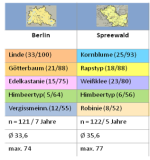Authentication of honey from selected regions
Jointly financed by the European Union and the German federal states of Berlin, Brandenburg, Saxony-Anhalt, Saxony and Thuringia
While regional products are gaining more attention, none of them have more terroir than honey. Marketing regional products strengthens competitiveness and serves as a consumer guide for tested quality — an image improvement for the region. Honey is a popular souvenir, particularly at attractive tourist locations.
Whether urban or rural region, the microscopic pollen spectrum not only reflects the botanical but also the geographical origin of honey. For this project, candidate regions were selected that permit a characterisation in terms of their landscape and flora (e.g., the urban area of a large city, biosphere reserves). Honey samples from a given region were examined organoleptically and chemically/physically. The pollen spectrum with the typical regional melliferous plants is documented and a typical profile of these honey types is created. The results of the analyses were presented annually to the beekeepers participating in the project and then discussed.
For the metropolitan area of Berlin, the project was completed in 2012. Count, distribution and period of the studied samples allow for a good characterisation of the typical Berlin honey types dependent on the harvest time. Accordingly, there are three distinguishable categories: "Berlin spring honey", "Berlin early summer honey" and "Berlin summer honey". Forget-me-not (Myosotis) is always present. The rape(type) share (Brassica type) is very low (10-15%). Pollen diversity is high, main melliferous plants are trees. Summer honeys also have characteristic chemical and physical properties.
For beekeepers in Berlin, there is the opportunity to present our results of the "Berlin city honey" as a poster, in order to be able to show their customers the variety of melliferous plants of their honey.
For all other regions, it has already been shown that the summer honeys are the most interesting type for the project, since the rape percentage is dominant in the more rural regions during the spring period.
In the Spreewald region, the summer honeys have a higher proportion of wild plants amongst the major melliferous plants, along with a similarly large pollen diversity as those of Berlin. The dominant melliferous plant is cornflower in addition to rape and white clover. "Spreewälder Stiftungshonig" (Spreewald Foundation Honey) was established by the foundation Bürgerstiftung Kulturlandschaft Spreewald e.V. on the basis of the project, the sale of which is to serve the regional promotion of landscape, beekeepers and Spreewald farmers.
In the other areas under study, both period and number of samples were insufficient to yield valid results. These include the eastern range of the Erzgebirge - Freiberger Mulde,the biosphere reserve Upper Lusatian Heath and Pond Landscape and the Saale-Unstrut-Triasland Nature Park. Further studies are required to compensate for weather-related influences, for example.
Figure: Results of the summer honeys (dated 07/2013): the plants most often occuring in honey, per region (%/honey / in % of the honeys) n = number of samples / year examined; max. = maximum number of pollen types / honey; Ø = avg. number of pollen types in all honeys examined in the region.
- Authentication of honey from selected regions
- Sucrose degradation during the storage of honey: impact of time, temperature, enzyme activity and botanical origin
- Development of a new test method for the quality analysis of honey
- Influence of honey ingredients on the development of the bee
- Evidence for correlation between invertase activity and sucrose content during the ripening process of honey


